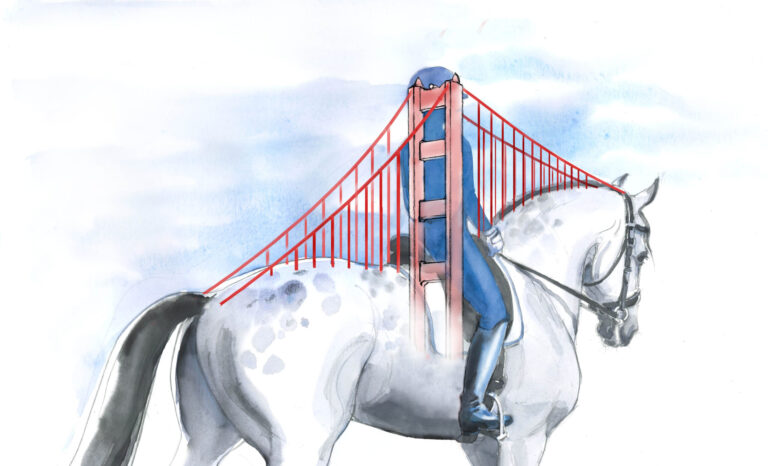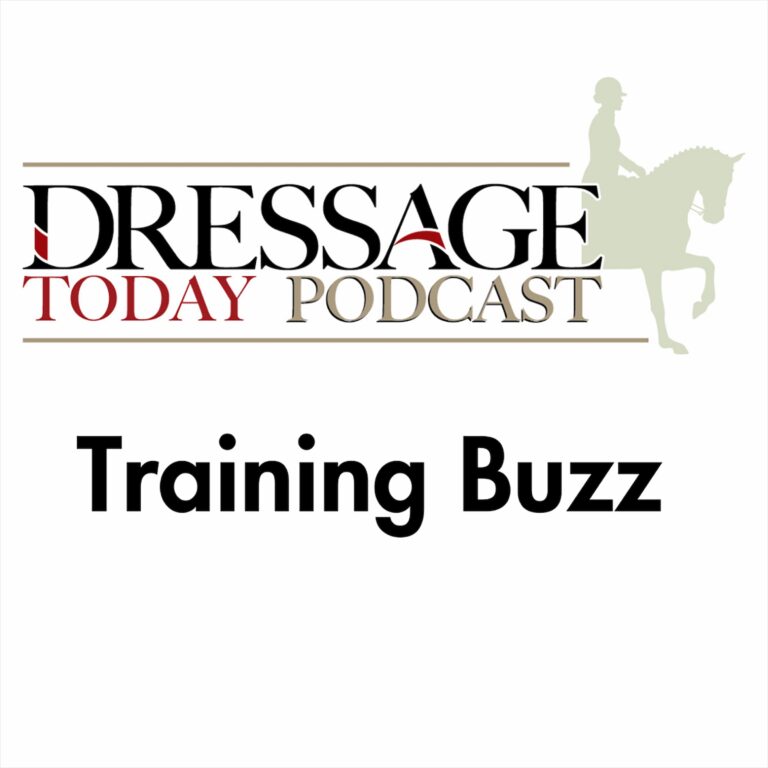Q: I am training an Andalusian gelding. I know the breed is famous for its ability to collect, but I am wondering the best ways to work on freeing the shoulder to lengthen the gaits and do extended trot. —Name withheld by request
A: I am asked this question often by riders who own Lusitanos and Andalusians. Yes, Andalusians are well known for their collection work and for their broad, powerful necks and crests, which give the impression that they are born on the bit. This is a mistaken impression. In reality, because of their neck conformation, it is very important that you have a good elastic contact and actively encourage the horse to follow the hand and extend his neck.

In walk especially, you should have a following contact—move your hands forward to encourage the neck to lengthen. Too often, I see Andalusians with poor walks. People have the idea that these horses are meant to work in collection since it is so natural for them. In reality, working on the walk to medium and extended with a good following connection will develop your ability to control the paces within the walk using your seat and balance. It will help you feel and assess what you need for the trot work. When your hands are not fixed or set, your horse will be able to extend and lengthen his frame and show good activity and expression.
What allows an Andalusian, or any horse for that matter, to shine and display his best athletic abilities is correct training that harmoniously develops his willingness, strength and paces. What allows the horse to move with great freedom, impulsion and expression and to lengthen or extend the walk, trot and canter are the very same qualities that are necessary to have good-quality collection in walk, trot and canter and to develop a good-quality piaffe, passage and pirouette. Extension and collection are two sides of the same training coin. I mean that for both we are using the same medium, which is the horse: his body, his mind and his spirit. To create beauty and expression, whether we wish to collect or extend, we have to work with his body.
First, he must be prepared and receptive mentally to our message, to our asking, so his body will not be tense and contracted in worry, but supple and willing to work with us.
Second, he must be able physically to do what we ask of him since the same body will be solicited in collecting or extending, only differently. Elasticity born out of good training is what allows for the body to extend and cover the most ground in extension or to gather itself in the utmost collection. This is not meant to deny that conformation plays an important role and horses with different conformation have different strengths and weaknesses. However, each horse will do better at lengthening and collecting if the rider understands the relationship between both and rides accordingly. To be successful in developing both, we must develop the horse so that he is elastic through his entire body, his topline especially. He must be loose, supple and flexible as well as straight, balanced and rhythmical. All these requirements must be present in the horse concurrently to obtain expressive and correct movements.
When the horse is elastic, he can collect and extend and do so without strain and tension. With Andalusians, who are so easily rounded up and collected, it is very easy to ride the horse’s neck and head instead of his whole body. This shortening and compressing of the neck, bringing the nose behind the vertical and holding the horse in place, introduces tension and stiffness in the horse’s body. Misunderstood collection and the resulting tension and stiffness are what often create blockages in the horse’s body, restricting the shoulders, back and pelvis, and hindering the freedom of movement and expression we seek in lengthened and extended gaits.
To extend, the horse has to be able to push evenly with his hind legs and receive the weight evenly on his forelegs. In trot, a two-beat movement, his body moves side to side, not up and down, and if the rider blocks the horse’s front end by bringing his nose behind the vertical or breaking his neck at the third vertebra, he prevents the very lengthening he is seeking. A stiff topline prevents the pelvis from coiling properly, the legs from stepping under and pushing evenly, the back from coming up and the neck from arching forward and out, giving the shoulders room to move. This contracted posture prevents the horse from lengthening from nose to tail.
I often see riders asking for two contradictory things: for the body to stay collected and the legs to extend. Often these riders will keep the horse collected in all his work, not realizing that without changing the horse’s frame, without developing elastic, flexible, supple muscles, both collection and extensions suffer.
Instead of working specifically on lengthening and extensions when I train a horse, I train him as a whole. I have a basic working position with a forward, down-and-out neck with the nose always slightly in front of the vertical. This position allows me to work all the horse’s large muscle groups and get the blood pumping and the oxygen circulating.
I pay special attention to each horse’s rhythm and to helping him find his own balance. I do not carry the horse. I want him to find his balance or self-carriage, so I accept that he may lose his balance and raise his neck a step or two here and there until he has developed enough strength to step forward confidently.
I do not rush the horse in trot because that would make him run, damage the trot’s quality and/or frighten him. Rushing also puts him on his forehand. What I do is find and develop his individual rhythm and help develop his balance through different exercises that help distribute his weight over his four feet and develop an even muscle mass. The more even the horse is, the better the gaits.
One exercise I use a lot is the shallow loop, starting with a three- to four-meter simple loop on the long side and building up to steeper ones, doing two in a row or adding a volte at the apex of the loop. I also use shoulder-fore and shoulder-in as well as renvers and travers, first on the wall and then on the quarterline and in combination with circles. These exercises are great to develop shoulder range of motion and to work on regularity and diagonal coordination, which are essential for good trot work.
When I feel the horse has developed some strength and balance and moves evenly and with regularity, I begin to play with extending and shortening his frame for a few strides here and there. I pay special attention to the horse remaining soft in the mouth and the back because his shoulders will be only as free as his back is. I make sure my horse is prepared.
In the beginning, I ask for lengthening and eventually extensions on very short diagonals or on the long side, but just for a few strides. Short diagonals work well because the horse understands quickly that once he reaches the wall, he will be done, and I find that most do not mind the effort. It is very discouraging for a horse who is learning to travel across an entire diagonal or long side and maintain the same level of energy.
I make it easy for the horse by asking him to take a couple more collected strides before I ask for the extension so that he does not have to exert a great effort to lengthen as he would if I asked from a working or medium gait.
To encourage him to reach for contact and lengthen the reach in his stride, I slowly increase my rising trot, lengthening his frame with my hands and a little pressure from my legs. I do not keep him in one trot. I vary the paces within the gait. First, I encourage more forward and longer strides, then I decrease my trot. I encourage the horse to follow my lead and travel with balance between paces as I decrease and increase the trot.
This allows him to find it easier to stay balanced and rhythmical as he learns to move from one frame to another. Just like with human athletes, horses have different learning curves and fitness curves, so I pay attention to how each horse responds to the work and I adjust my demands so I do not make him sore or discourage him. I remember that lengthening and especially extensions are hard work, so I ask little and reward a lot.

Jose Mendez is an hon. fellow of the International Society of Rider Biomechanics (ISRB) and a Level 3 coach for the Equestrian Federation of Australia. He began his riding career at the Real Escuela Andaluza del Arte Ecuestrein Jerez, Spain. In competition, he has represented Australia at the Southern Hemisphere Games. He was a featured performer at Equitana Australia and recently at Equine Affair in the United States. He trains horses in hauteécole as well as develops them for FEI-level competition at the Mendez Equestrian Centrein Tallong, Australia.











